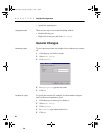
64
C H A P T E R 4 Advanced Configuration
64
However, IP policies cannot be used for devices using tagged VLANs
and IP learning is not possible. In addition to this, tagged frames can-
not be routed between VLANs.
VLANs (Virtual LANs)
Purpose You can use VLANs to:
• Create up to 128 separate user groups
• Limit broadcast and multicast traffic
• Increase security by limiting communication between groups
• Allocate network resources (such as servers) to groups
For a more comprehensive explanation of the VLAN concept, refer
to the online help.
Warning when using STP It is important to be aware of problems that may arise when using
Spanning Tree and VLANs. The Spanning Tree can use alternative
paths (such as different ports) to get messages to their destination.
VLANs specify which ports can receive messages (see “Spanning
Tree”, p. 55).
Warning When using the Spanning Tree facility, use only one
VLAN. If you use two or more VLANs, unexpected
changes in your network topology may occur.
Policy-based VLANs The switch or stack uses “Policy-based VLANs”. This means that the
devices attached to the switch/stack can be grouped by any combina-
tion of MAC address, IP address, IP net and port number; therefore,
devices can belong to one or more VLANs.
Policy hierarchy To avoid conflicts between two VLANs, a strict priority of the poli-
cies is used:
1. MAC address
2. IP address and IP net
500.book Page 64 Thursday, September 2, 1999 1:44 PM


















